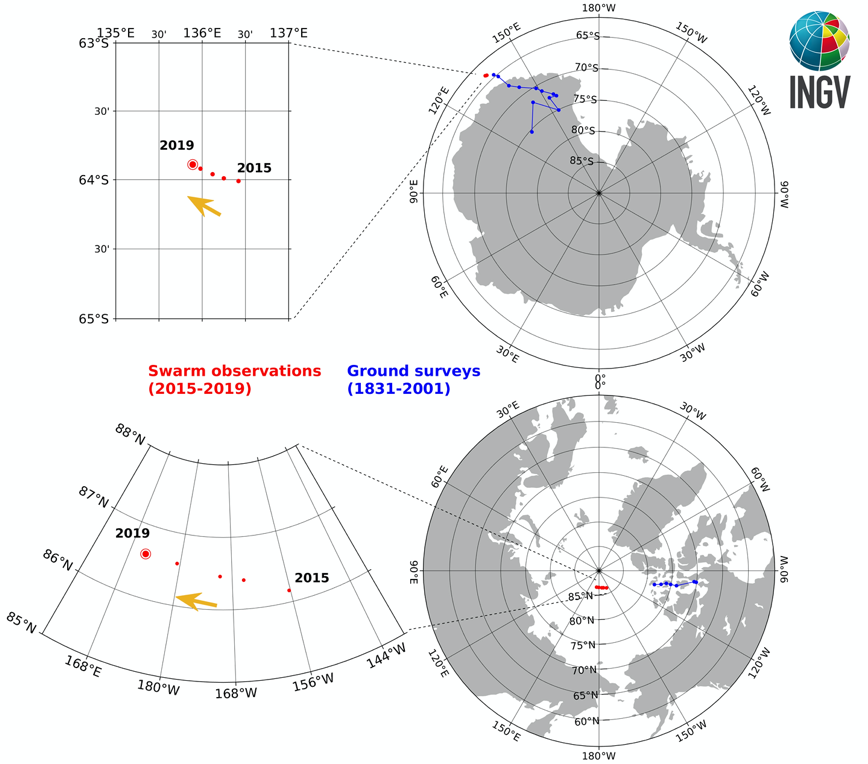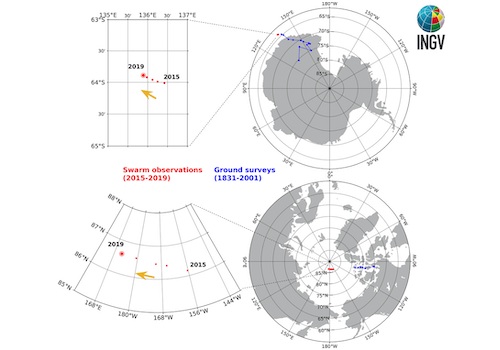Confermata la corsa del polo magnetico nord verso la Siberia attraverso le osservazioni dei satelliti europei Swarm. Lo studio dell’INGV, appena pubblicato sulla prestigiosa rivista americana Journal of Geophysical Research, ne illustra i particolari
Con una velocità otto volte maggiore rispetto a quella del polo magnetico sud, il polo magnetico nord si muove verso la Siberia. Una nuova analisi effettuata per la prima volta sui dati prodotti dai satelliti Swarm dell'European Space Agency (ESA) attualmente in orbita, hanno confermato il trend che si era rilevato negli ultimi decenni. Nello studio appena pubblicato "The location of the Earth's magnetic poles from circum-terrestrial observations", tre ricercatori dell’Istituto Nazionale di Geofisica e Vulcanologia (INGV) mostrano come dalle misure dirette del campo magnetico registrate dagli strumenti a bordo dei satelliti sia possibile determinare la posizione aggiornata dei poli magnetici e, analizzando i dati degli ultimi anni, anche la loro dinamica.
“I tre satelliti Swarm”, afferma Domenico Di Mauro, ricercatore dell’INGV e autore dello studio, “sin dal loro lancio nel 2013, compiono orbite quasi polari in circa 95 minuti. In 24 ore effettuano 15 giri intorno alla sfera terrestre raccogliendo, così, informazioni sulla morfologia e sulla intensità del campo magnetico con strumenti di altissima precisione e restituendo misure con una risoluzione ed una copertura spazio-temporale mai raggiunte prima. Un’opportunità che noi ricercatori dell’INGV operanti nell'ambito del geomagnetismo non potevamo farci sfuggire: abbiamo così determinato, aggiornandola, la posizione dei poli magnetici come se la misura fosse raccolta a terra. Per far ciò, abbiamo messo a punto procedure ed algoritmi per proiettare i dati raccolti in quota sulla superficie terrestre, un’analisi realizzata per la prima volta nell’era dell’esplorazione del nostro pianeta dallo Spazio”.
“I risultati”, aggiunge Mauro Regi, ricercatore dell’INGV e primo autore dello studio, “in accordo con l'attuale 13esima generazione del modello internazionale di riferimento del campo geomagnetico (IGRF), hanno la prerogativa di restituire un'informazione immediata e diretta da osservazioni sperimentali. Entrambi i poli magnetici si muovono in direzione nord-ovest ma mentre il polo nord si muove alla velocità di circa 37-72 km all’anno (con una lieve diminuzione nell'anno 2016), la velocità del polo sud è di circa 5-9 km all’anno. Dalle nostre analisi, quindi, il polo nord magnetico ha abbandonato i territori settentrionali del Canada e si dirige verso la Siberia, mentre il polo sud magnetico si muove più lentamente verso l'oceano aperto, dal settore antartico che ospita la stazione francese Dumont D'Urville”.
“Importante è sottolineare”, conclude Stefania Lepidi, ricercatrice dell’INGV e co-autrice dello studio, “la profonda differenza tra poli magnetici e poli geografici: questi ultimi sono individuati dall'asse di rotazione terrestre e, dunque, sono fissi. I poli magnetici, invece, corrispondono ai punti in cui il campo magnetico è esattamente verticale e si muovono in maniera imprevedibile. Inoltre, i poli magnetici non sono diametralmente opposti come quelli geografici e non sono neanche vicini ad essi. Oggi il polo sud magnetico dista dal suo omologo geografico circa 2800 km, quello nord circa 350 km”.
Il bizzarro comportamento dei poli magnetico ha stimolato la curiosità di alcuni esploratori negli ultimi due secoli, temerari fino a fronteggiare le difficili condizioni ambientali delle aree polari del nostro pianeta: le preziose misure raccolte nel corso del tempo hanno permesso di seguire le incredibili distanze coperte dai due poli magnetici, come manifestazione della lenta ma continua variazione spazio-temporale del campo magnetico in conseguenza dei complessi meccanismi che lo generano nel nucleo esterno del nostro pianeta.
#ingv #esa #swarm #polimagnetici
---
The fast journey of the magnetic North Pole towards Siberia measured by the European Swarm satellites
The race of the north magnetic pole towards Siberia has been confirmed through the observations of the European Swarm satellites. The INGV study, just published in the prestigious American Journal of Geophysical Research, illustrates the details
With a speed eight times greater than the one of the south magnetic pole, the north magnetic pole is moving towards Siberia. A new analysis carried out for the first time on the data produced by the Swarm satellites of the European Space Agency (ESA) currently in orbit, confirmed the trend that had been observed in recent decades. In the study just published "The location of the Earth's magnetic poles from circum-terrestrial observations", three scientists of the Italian National Institute of Geophysics and Volcanology (INGV) show how from the direct measurements of the magnetic field recorded by the instruments on board the satellites it is possible to determine the updated position of the magnetic poles and, analyzing the data of recent years, also their dynamics.
"Since their launch in 2013”, says Domenico Di Mauro, scientist at INGV and author of the study, "the three Swarm satellites complete near polar orbits in about 95 minutes. In 24 hours, they perform 15 turns around the Earth's sphere, thus collecting information on the morphology and intensity of the magnetic field with very high precision instruments and returning measurements with a resolution and space-time coverage never achieved before. An opportunity that we, INGV researchers working in the field of geomagnetism, could not miss: we thus determined, updating it, the position of the magnetic poles as if the measurement were collected on the ground. To do this, we have developed procedures and algorithms to project on the Earth's surface the data collected at high altitude, an analysis carried out for the first time in the era of the exploration of our planet from Space".
"The results", adds Mauro Regi, scientist at INGV and first author of the study, "in accordance with the current 13th generation of the international reference model of the geomagnetic field (IGRF), have the prerogative of providing immediate and direct information by experimental observations. Both magnetic poles move in a northwest direction but while the north pole moves at the speed of about 37-72 km per year (with a slight decrease in the year 2016), the speed of the south pole is about 5- 9 km per year. From our analyses, therefore, the magnetic north pole has abandoned the northern territories of Canada and is heading towards Siberia, while the magnetic south pole moves more slowly towards the open ocean, from the Antarctic sector which houses the French station Dumont D'Urville".
"It is important to underline", concludes Stefania Lepidi, scientist at INGV and co-author of the study, "the profound difference between magnetic poles and geographical poles: the latter are identified by the Earth's rotation axis and, therefore, are fixed. The magnetic poles, on the other hand, correspond to the points where the magnetic field is exactly vertical and move in an unpredictable way. Furthermore, the magnetic poles are not diametrically opposite as the geographic ones are and they are not even close to them. Today the south magnetic pole is about 2800 km from its geographical counterpart, the north one about 350 km".
The bizarre behavior of the magnetic poles has stimulated the curiosity of some explorers in the last two centuries, daring to face the difficult environmental conditions of the polar areas of our planet: the precious measurements collected over time have made it possible to follow the incredible distances covered by the two magnetic poles, as a manifestation of the slow but continuous space-time variation of the magnetic field as a consequence of the complex mechanisms that generate it in the outer core of our planet.
#ingv #esa #swarm #magneticpole

Figura 1 - Posizioni dei poli magnetici nord e sud rilevate da campagne di misura a terra nel corso di due secoli (punti blu) e da recenti rilievi della strumentazione a bordo dei satelliti Swarm (punti rossi). La posizione attuale (2019) dei poli è indicata da un punto rosso cerchiato.
Figure 1 – Positions of the north and south magnetic poles by ground surveys over two centuries (blue points) and by the latest observations from instrumentation on board of the Swarm satellites (red points). Current poles’ position (2019) is marked as a red-circled point.




